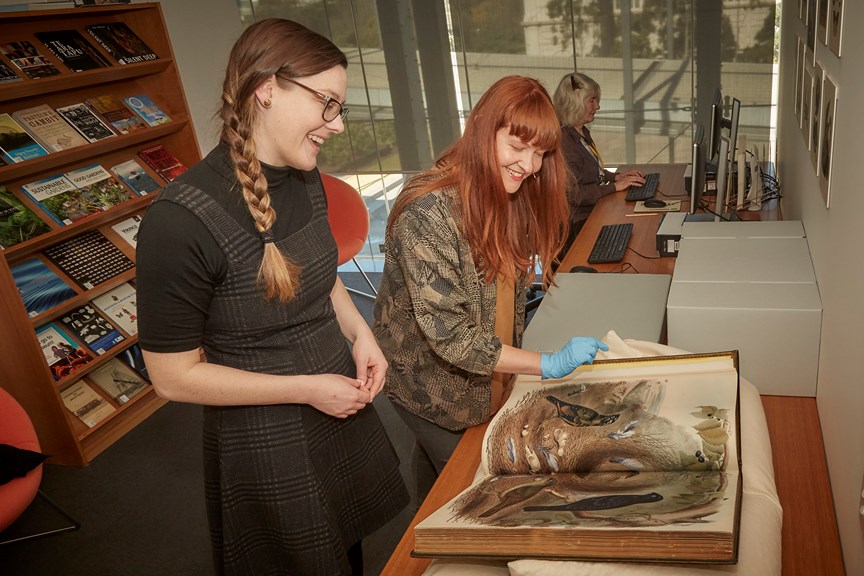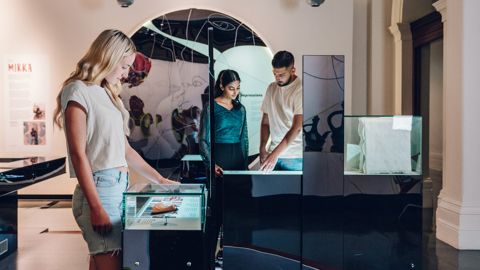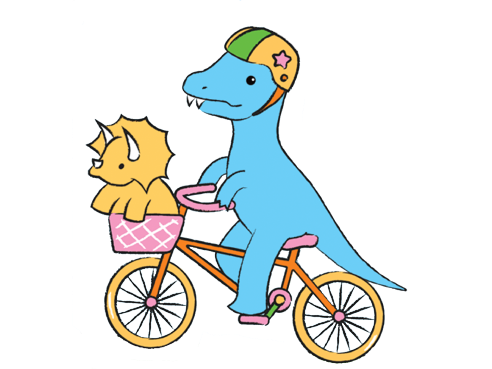Interview with Hayley Webster
Manager of Museums Victoria’s Library
Tell us about your role.
I'm the manager of the library at Museums Victoria. It’s a historic library that dates back to the 1850s. So there's been a library at the museum since it was founded. We have a rare book collection as a consequence, because we've been collecting for such a long period.
How long have you been at the Museum?
10 years. I’ve had a few roles at MV. I started out as a student on placement in the library. I had been thinking of going into academic libraries, but as soon as I started working at the museum I fell in love with the environment. The first official role that I had was working in Image Management & Copyright doing image research on exhibitions, some of which members will be familiar with, such as the 600 Million Years exhibition. Then I became the librarian. I was the librarian for a few years and I have now been the manager for six years. In that role I oversee staff, the budget and planning. It's also to do with decision making around the collection and its development. I’m sometimes involved in cross-departmental working groups that look at different things from a broader organisational perspective like digitisation, collection security, and information and knowledge management. Because I work with such a small team—there are three of us—I'm still involved in the day-to-day stuff too.
What does a typical day look like for you?
There's no such thing as a typical day in the library. That's actually one of the things that I like about the job. The museum is a very diverse place with a lot of different activities happening all the time. And one of the things the library has to do is to respond to all of that. So, while we make plans and have ongoing tasks that we do, we're really very responsive. A day for me could look like going in, responding to a staff member standing in front of me asking for a book. So I'm going to go and get the book off the shelf for them. Then I could be doing a budget build. I could be supervising students or volunteers. I could be having to do some provenance research on a rare book. Yeah, it's really very varied. I love the fact that it's so diverse – it's really interesting. It keeps it fresh.
What would a staff member require a book for?
One of the library's main functions is to support the research activities of the museum. Staff use the library for all sorts of research, including exhibition development, writing academic publications, creating educational programs, presenting tours or talks, and maintaining current awareness in their field.
Can the public access the MV library?
The public can access the library by appointment. We have a Reading Room available to facilitate library access for the public and visiting scholars and our library holdings are available on Trove. We also run public events, such as for Melbourne Rare Book Week (our 2019 recordings are available on Soundcloud). For Museum Members, we have previously offered behind the scenes tours which we might do again in the future, COVID-permitting.
Can people donate books to the library?
Members of the public can donate to our library collection the same way that they donate to the rest of Museums Victoria’s collection. That happens on a reasonably regular basis, so one of my jobs is to assess those donation offers as they come in. We have to be a bit selective about what we take because we don't have all the room in the world, but I've facilitated many donations over the time that I've worked here.
What courses or experience does one need to work in a similar field?
I've got a Graduate Diploma in Information Management and that's the kind of course that would qualify you to be a professional librarian. I have a background in history. I did a BA and honours in history and that has turned out to be very applicable to working in a museum with an historic collection. It's particularly helpful when working with the Rare Book Collection. There are other courses that you can do to become a library officer or library technician or something like that, and many people working in libraries don't have specific qualifications. The higher up you go, it tends to be that you need a Graduate Diploma or Masters. A lot of people would undertake a Masters these days. I did my training ten years ago so I didn't do that, but a lot of the new graduates do that now.
How have things changed due to COVID?
It's been interesting because we have a primarily print-based collection. A lot of other libraries have moved very much towards the online environment in recent years. Our library is reasonably traditional actually, and is still heavily reliant on print resources, although we do have some electronic material.
That has meant that not being on site thrown a real spanner in the works! We've had to shift towards providing a lot more online access, so that's one thing we've been focusing on. I've been able to focus on things that I would not normally be able to devote so much time to just because it's normally a fairly busy environment. I've been doing a lot of work with our rare book collection and that's been really interesting and really rewarding.
Some online projects I’ve been working on include the Biodiversity Heritage Library and blog which might be of interest to members. They can browse a lot of out of copyright, old scientific books which are full of beautiful illustrations. I’ve also been working on a new Trove collection feature called Australia’s biodiversity in print and online.
I've also been looking at developing a wish list for our rare book collection: in an ideal world, if we could have whatever [books] we wanted, what would we choose?
What’s on your rare book wish list?
Our collection of natural history books has been built by professional scientists interested in the content of these books for research. Over time we have become more interested in these books as objects; their beauty, their history and their value. The oldest book in our collection is a book on shells by Martin Lister from 1685, and it was scientifically important in its time. As I have learned more about the history of science through working with our collection, I have wanted to know more about older natural history books – ones that predate or demonstrate the shift towards modern science. So, a few of the items on my list fall into this category. An example would be the bestiary by Edward Topsell The Historie of Foure Footed Beastes first published in 1607. It includes real animals that readers would have been familiar with, but also fantastical imagined animals. To me this work is charming, fascinating, and an important contrast demonstrating the more modern scientific focus of our collection.
What’s the best part of your job?
My favourite thing to do with the job is definitely the Rare Book Collection as there's so much of interest there.
What’s your favourite item in the library?
There's this incredibly beautiful item that is actually two titles bound into the one volume by the same woman who was a scientist in the late 17th and early 18th centuries. Her name is Maria Sibylla Merian. She was fairly unusual for her time, to be working in sciences as a woman, but she was respected and well connected. She was also very artistic and had an artistic career as well. She was fascinated with insects and their life cycle (metamorphosis) which she documented in these two books. One is about Europe and one is about Surinam, a Dutch colony in South America that she travelled to which, again, was not so common for a woman of her era. It was particularly considered shocking that she went there unattended by male chaperone! But she did and she published these two works and they're just absolutely extravagant and beautiful. I think this volume is the most beautiful item in our collection. It has a lovely binding called a tree calf binding, which is a high-end binding that would have been expensive. These bindings are made by running acid across the leather to create this sort of tree-like look, so the volume is quite impressive even before you open it up and see all the beautiful illustrations and hear Merian’s story, which always interests people. That's my favourite item, but once you start looking into any of the items there's often an interesting story to be told.







